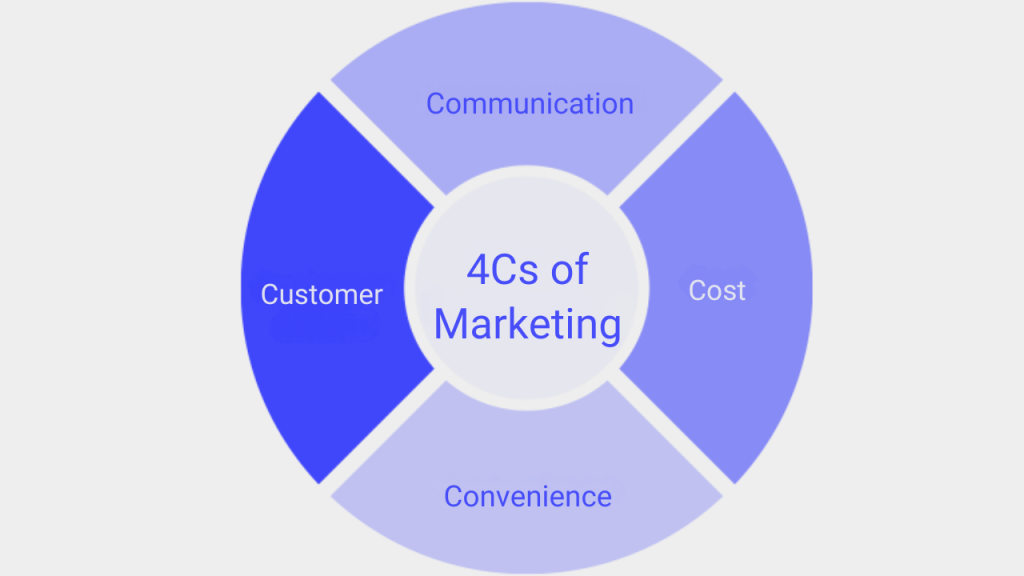Table of contents

Introduction to the 4C’s of Marketing
In today’s dynamic marketplace, understanding and meeting consumer needs is paramount for business success. The 4C’s of marketing – Customer, Cost, Convenience, and Communication – offer a modern framework for businesses to thrive in this competitive landscape. Originally introduced as an alternative to the traditional 4P’s, this model places emphasis on consumer-centric strategies and effective communication channels.
Understanding the 4C’s Model
- Customer: At the heart of any marketing strategy lies the customer. Businesses must strive to understand their target audience’s needs, preferences, and behaviours to craft products and services that resonate with them. Customer satisfaction is not just a metric but a fundamental pillar for sustainable growth.
- Cost: Marketing endeavours inevitably incur expenses, from product development to promotional activities. Evaluating the costs involved is essential for optimizing strategies and ensuring a favourable return on investment (ROI). Moreover, understanding the perceived value of offerings aids in pricing decisions and competitive positioning.
- Convenience: In today’s fast-paced world, convenience plays a significant role in consumer decision-making. Whether it’s the ease of purchasing online or the accessibility of physical stores, providing a seamless shopping experience enhances customer satisfaction and fosters loyalty. Businesses must prioritize convenience at every touchpoint of the customer journey.
- Communication: Effective communication is the cornerstone of building brand awareness and fostering customer relationships. Through various channels such as advertising, social media, and personalized messaging, businesses can convey their value proposition and engage with their target audience. Consistent and compelling communication helps establish brand credibility and trust.
Applying the 4C’s Model in Marketing
- Know Your Audience: Define your target market and tailor your marketing efforts accordingly. Conduct thorough market research to understand consumer demographics, preferences, and pain points. By segmenting your audience and creating personalized experiences, you can enhance engagement and drive conversion rates.
- Cost-Effective Strategies: Allocate your marketing budget wisely, focusing on initiatives that offer the highest ROI. Whether it’s digital advertising, content marketing, or influencer partnerships, prioritize tactics that align with your budget and business objectives. Monitor and analyze campaign performance to optimize spending and maximize results.
- Enhance Convenience: Streamline the purchasing process for customers by offering multiple channels for transactions and ensuring a user-friendly interface. Whether it’s optimizing your website for mobile or providing hassle-free checkout options, prioritize convenience at every touchpoint. Additionally, consider implementing innovative solutions such as subscription services or loyalty programs to enhance customer convenience and retention.
- Effective Communication: Develop a cohesive communication strategy that resonates with your target audience across various platforms. Tailor your messaging to address consumer needs and concerns, leveraging storytelling and visual content to enhance engagement. Foster a dialogue with your audience through social media listening and feedback mechanisms, allowing you to adapt your communication strategy in real-time based on consumer insights.
Case Studies and Examples
- Amazon: By prioritizing customer convenience and leveraging data-driven insights, Amazon has revolutionized the retail industry. With features such as one-click ordering, personalized recommendations, and fast shipping options, Amazon has redefined customer expectations and set a new standard for convenience in online shopping.
- Dollar Shave Club: Through its disruptive marketing campaigns and subscription-based model, Dollar Shave Club has successfully differentiated itself in the crowded men’s grooming market. By offering a convenient and cost-effective solution for purchasing razors and grooming products, Dollar Shave Club has amassed a loyal customer base and disrupted traditional retail channels.
- Nike: Nike’s “Just Do It” campaign is a quintessential example of effective communication and brand storytelling. By tapping into the emotions and aspirations of its target audience, Nike has created a powerful brand identity that resonates with consumers worldwide. Through its strategic partnerships with athletes and influencers, Nike continues to engage and inspire its audience across various touchpoints.
Conclusion
The 4C’s of marketing provide a contemporary framework for businesses to navigate the complexities of today’s marketplace. By prioritizing customer-centric strategies, optimizing costs, enhancing convenience, and fostering effective communication, businesses can create meaningful connections with their audience and drive long-term success. By embracing the principles of the 4C’s model, businesses can adapt to changing consumer behaviors and emerge as leaders in their respective industries.

